From the NES to the N64 to the Wii, Nintendo has always been the vanguard of console innovation. As the Wii U recently demonstrated, their innovative ideas haven’t always worked out, but their willingness to experiment has done wonders over the years to broaden the toolkit available to game developers.
The Switch has rightly been hailed as Nintendo console innovation at its finest: it combines TV gaming with portable gaming, motion controls with classic controls, all in the kind of friendly, fun-to-use package that Nintendo has taught gamers to expect from them.
Fine. But how much does the Switch matter, really?
There are two kinds of possible console innovations: those that impact the storytelling capabilities of games, and those that don’t. Advancing graphics to the point where gamers could see well-articulated expressions on the faces of game characters probably made a difference to the kind of storytelling possible in video games; advancing graphics from HD to 4K HD, on the other hand, probably didn’t.
No doubt, there are many reasons why one might want to make console innovations that don’t impact the storytelling capabilities of games; but when you’re principally interested in video games as a method of storytelling, it makes sense to ask the question of how much a particular innovation matters to the status of video games as a storytelling medium. That’s the question I want to ask of the Switch in this article: in what ways, if any, has the Switch expanded the storytelling capabilities of video games?

The reason why I’m excited to see what comes of the Switch is that I do think it has the potentially to markedly expand the range of video games’ unique storytelling tools. I focus here on the three aspects of video-game storytelling that I think the Switch is best poised to impact in a meaningful and lasting way:
- players’ relationships with avatars
- players’ relationships with game worlds
- players’ relationships with each other
The unifying theme to these three potential impacts of the Switch is the console’s dynamism—put briefly, I think the name “Switch” extends to the kinds of stories the console can tell, not just the literal ability of the console to Switch between connecting to a TV and being portable.
Groundwork: Why Consoles Matter to Storytelling
Let me take one step back before stepping into an analysis of the Switch. Do the capabilities of a particular console really make a difference to the kinds of stories that it can tell? You might doubt this: after all, many games are released for both Sony and Microsoft’s consoles (e.g., Assassin’s Creed), and it seems as if there’s no meaningful difference between the games’ stories in the Xbox version versus the PlayStation version.

Ubisoft actually seemed to emphasize that choice of console made no difference to playing these Assassin’s Creed titles.
It’s probably true that the choice of playing a game on Xbox or PlayStation doesn’t categorically make a difference to the game’s storytelling, but it’s a mistake to generalize from that observation to the storytelling values of consoles more generally. Let me offer three arguments—one from general theoretical considerations, one in the form of a case study, and one through a comparison with other storytelling media—to convince you that the nature of consoles can and often does make a difference to storytelling.
First, the theoretical argument. I’ve argued many times—most recently in a thesis on the ontology of video games as a storytelling object—that the players of video games play foundational roles within the fictions that those video games represent. This means that players don’t just “interact” with video games in the way that a reader “interacts” with a book by turning its pages, manipulating the storytelling object without actually having any causal influence within the fictional world that the object represents: rather, it’s true within the fiction of video games that the player is an entity with the ability to actualize the fictional world and events of that video game.
Without digressing into the details of the argument for the special fictional role that the player occupies, we can make the following, intuitively plausible argument.
- Players are able to influence the worlds of video games within the fictions of those video games, and that influence makes a difference to video games’ stories.
- Consoles mediate the influence that players have on the worlds of games, and different consoles can mediate that influence in different ways.
- Thus, to the extent that different consoles mediate players’ influence on game worlds in different ways, consoles make a difference to video games’ stories.
Notice that this argument also explains why the difference between PlayStation and Xbox doesn’t typically make a difference to the storytelling of video games: the two consoles are typically functionally equivalent with respect to the kind of influence they allow a player to exert on the worlds of video games. In contrast, a Wii, in virtue of its motion controls, has the potential to give a player a radically different kind of influence over the world of a video game’s story—and, intuitively, the difference between a Wii and an Xbox does seem like the kind of thing that could in principle impact the storytelling of video games.

Our argument endorses the intuitive view that the storytelling difference between a Wii and an Xbox is greater than the storytelling difference between an Xbox and PlayStation.
A case study will make the impact of consoles on storytelling more vivid. When I founded With a Terrible Fate back in 2014, I started my work on game analysis by analyzing The Legend of Zelda: Majora’s Mask throughout the three-month period leading up to the release of its remake for the Nintendo New 3DS. I studied many aspects of the game during that time, including whether it mattered that the remake was being made for a portable console, whereas the original (along with its subsequent ports) was made for a TV console (or, as I referred to it back then, a stationary console). I concluded that this difference between consoles had radical implications for the world and story of the game.
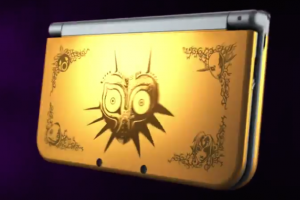
Majora’s Mask features the bizarre world of Termina, into which Link, the player’s avatar, stumbles three days before its annihilation (Skull Kid plans to crash the moon into Termina, destroying it). Link’s journey to save the world consists of him doing as much as he can to advance his quest in those three days, and then playing the Song of Time to jump to a new, three-day timeline leading up to Termina’s destruction, proceeding in this way through different iterations of the same 72 hours leading up to the apocalypse.
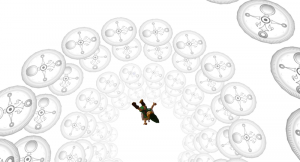
Link is constantly jumping from timeline to timeline in order to buy himself more time in which to try to save Termina.
One of the primary arguments I developed over the course of my three months studying Majora’s Mask was that the world of Termina only exists in virtue of Link and the player encountering it. The full argument to this conclusion would take us too far off-course here, but the general idea is that the agency of Link and the player substantiate Termina from turning it from a nebulous set of possibilities into a world with well-defined, actual events (for instance: the Zora, Mikau, is in something like a Schrödinger’s Cat situation until Link and the player encounter him).
The fact that the original Majora’s Mask was played on TV consoles (the N64, GameCube, and Wii) directly reinforced this view of Termina’s metaphysics: just like Link “stumbled upon” Termina by falling down a quasi rabbit hole, the player “stumbled upon” the world of Termina by turning on their console and peering into that bizarre world. Because the game is played on a console that’s typically hooked up to a single TV in a single location and not really moved around thereafter, the game reinforces the idea that the player is able to peer into a universe that is not only derivative of her own universe, but that is also dependent on her own agency to exist. Moreover, the player can only save her progress in the game by either playing the “Song of Time” to complete one timeline of Termina and start another one, or by using an Owl Statue to temporarily save the game, creating a save file that requires the player to exit out of the game itself, and that is deleted as soon as the game is resumed. This further reinforces that the game’s world really only manifests when the player is around to see it: the world of Termina is fundamentally confined to the singular, real-world location of the player’s TV, which supports the idea of the world depending entirely on the player’s existence.
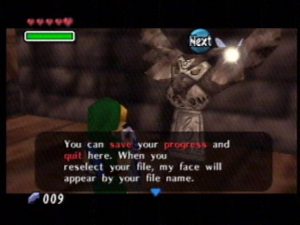
The fact that Owl Statues only let you record your progress in the game temporarily, requiring that you exit the game in order to do so, reinforces the idea that Termina’s very existence is contingent on the player experiencing it.
Now contrast this view of Termina and its relation to the player with the very different kind of relation we see between Termina and the player in Majora’s Mask 3D, the Majora’s Mask remake that lives on the portable console of the Nintendo New 3DS. In virtue of the console being portable, the player can access Termina from anywhere in the real world; not only that, but the console’s gyroscope let the player (for instance) aim Link’s bow by literally moving around the console in space, creating a sense that the world of Termina is mapped onto the real world as if it were a parallel dimension, rather than being a separate world accessed by and derived from the player. In the same spirit, the addition of Save Statues allow players of the remake to save the game at any point in a three-day timeline without thereby needing to quit the game. All of this suggests that Termina in Majora’s Mask 3D is a world that exists independently of the player: it is a world that is parallel to the player’s that the player can access using her New 3DS, but it exists out there in space whether or not the player decides to access it in this way.
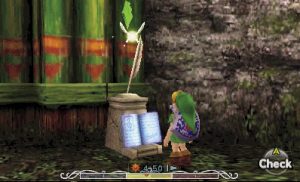
Save Statues effectively reverse the metaphysical implications of the original Majora’s Mask’s Owl Statues.
I concluded from these considerations that the shift from TV console to portable console made a huge, foundational difference in the story of Majora’s Mask by radically changing the world’s metaphysics: the TV console lent itself to a Termina whose very existence depended on the player, whereas the player was merely an existentially independent visitor to Termina on the portable console.
So, when we analyze the stories and worlds of video games, we need to be sensitive to how the particular console on which they’re published might influence those stories and worlds. Often, turning our attention to the nature of the consoles themselves will allow us to understand video-game storytelling in new ways.
And, by the way, this isn’t an especially new feature of storytelling, either: the storytelling impact of game consoles is a particular application of a general principle that we also observe in media like movies and novels. The principle is this: when a work of fiction makes the real person engaging it a part of its fictional world in some way, the particular form in which the fiction is represented makes a difference to the work’s fictional world.
This principle is what we see at work in novels designed in the form of a series of letters that the reader is supposed (fictionally) to have discovered: the form of the work itself (a written work in the form of letters) is essential to making this fiction of the reader discovering a series of letters possible. We see the same principle in “found-footage” films, where the reader is supposed (fictionally) to have discovered footage from a video camera documenting the events of the narrative: the work’s form (a film structured like a recording from a camcorder) is essential to making this fiction possible.
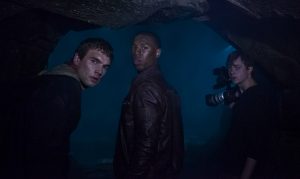
Chronicle, as a found-footage film, is an example of a film where the form of the storytelling medium is essential to the story being told.
The reason behind this general principle is that you cannot give a person engaging with a fiction a role within that fiction (e.g., the role of the person discovering a series of letters, the role of a person discovering camcorder footage) without thereby also involving the form of the fiction within the fiction: the form of the fiction is the only means through which a real person is able to access that fiction; it’s therefore the only means through which a real person could be given a role within that fiction, meaning that involving a real person in a fiction (by giving them a fictional role) will essentially involve reference to the form of the work itself.
The special feature of video games in regard to this is that their interactive nature means players are always given a role within their fictions. Thus, video games’ form—including the consoles through which they are represented—will always be relevant in fully understanding their stories. So we can’t afford to ignore the features of particular consoles when we think about the storytelling of video games.
“Switching” in Storytelling: The Potential of the Switch to Impact Video-Game Storytelling
With the storytelling value of consoles in view, let’s consider the potential that the Switch has to allow new kinds of stories to be told as video games. Like I said at the outset, I think the key to the Switch’s unique storytelling features is dynamism: more specifically, I want to convince you that the ability of the Switch to transition between many different physical gaming formats directly translates to the ability to tell new kinds of video-game stories. I’ll explore how this dynamism could impact the relationship of players with avatars, game worlds, and other players.
1. The Garden of Forking Avatars: Dynamic Point-of-View on the Switch
The Legend of Zelda: Skyward Sword was a departure for the Zelda series in many ways, but one in particular made a radical difference to how people actually played the game: using the Wii’s motion controls, the game actually allowed the player control their avatar, Link, by making the very movements they wanted him to make.[1] They swung their controller, the Wiimote, to make Link swing his sword, and they held their remote in their air to channel energy for the eponymous Skyward Strike.

As Ghirahim made clear during his first battle with Link, a huge part of Skyward Sword was learning how to swing the Wiimote in just the right way to make Link execute the right kind of attack.
These motion controls were a radical departure for the series, I suggest, because they didn’t just give the player a new mechanical way to play the game: they gave the player a new perspective through which to engage their avatar and the game’s world.
The various ways in which players can view and manipulate their avatars are like point-of-view in other storytelling media: the avatar is, first and foremost, the agent through which the player has access to the fictional world of the video game, and the avatar’s actions—determined by the player—are the spinal cord that supports the entire evolution of the game’s story—both in terms of any single playthrough of the game, and in terms of the broader matrix of all possible playthroughs of the games (what I’ve referred to elsewhere as a game’s possibility structure). In light of this, changes to the relationship between player and avatar correspond to changes in the point-of-view through which the player accesses a game’s story.
For a very common and straightforward example of what I mean, consider the difference between third-person games, in which the player views the world of the video game from some fixed perspective looking upon their avatar from outside of the avatar itself (as if a “camera” were trained on the avatar), and first-person games, in which the player views the world of the video game from a perspective representing their avatar’s visual field (as if the player were literally seeing the world “through the avatar’s eyes”). This difference influence the point-of-view through which the game’s story is expressed to the player: in a third-person game, the player has more of a “god’s-eye view” of the story, invited to consider the avatar and its actions as an outside observer, whereas first-person games invite the player to imagine that she is actually inhabiting the avatar’s perspective and acting as the avatar throughout the game.

First-person perspective in Dishonored, as the avatar, Corvo, takes a boat ride.

Third-person perspective in Breath of the Wild, as the avatar, Link, looks out at the vast world before him.
Motion controls in Skyward Sword impacted point-of-view in a similar way by facilitating a limited degree of kinesthetic correspondence: a high-fidelity transfer of the player’s bodily motions (swinging the Wiimote) to the avatar’s bodily motion (Link swinging his sword). This gave the player a way to actually feel like Link in a bodily way throughout the game: rather than symbolically making it the case that Link swings his sword by (for example) pressing the “B” button on a controller (what we might call symbolic controls, the pressing of a symbolic button to execute a particular in-game action), the player of Skyward Sword can take a different kind of ownership over Link’s actions by enacting those very same actions through the Wiimote.
This makes a difference to the kind of storytelling that happens in Skyward Sword, as opposed to the kind of storytelling that happens in other Zelda titles. It’s similar to the difference between a silent film and a film with sound: the presence of sound gives the viewer a new perspective on the film’s fictional world, giving them a new dimension in which to engage and understand characters, events, and the like. Just so, the player of Skyward Sword has an entirely new, kinesthetic dimension in which to engage and understand Link. The game doesn’t make the player embody Link in the way that something like virtual reality would (in fact, it actively enforces the difference between player and avatar by giving the player a third-person perspective on Link, despite the addition of kinesthetic correspondence), but it does give the player a new way of, for want of a better term, empathizing with Link.
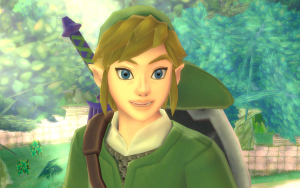
What is it like inside that smiling head? Motion controls give us a new way of answering that question.
Performing the same actions as Link allows the player to think more like Link because she is deciding to commit the very same bodily actions that she wants Link to commit. This is a starkly different player-avatar relationship than that of a player who can only determine avatar actions through a symbolic control system. Neither kind of relationship is necessarily better than the other, but the symbolic-system relationship gives the player a much more objective, separate perspective on Link than the kinesthetic-correspondence relationship does.
That, incidentally, may be one of the reasons why many fans of the Zelda series bristled at Skyward Sword: it’s not that the motion controls were a poor storytelling mechanic per se; rather, they created such a radically different relationship between the player and Link that veteran players of the series likely felt (as I did) a sense of alienation from this new point-of-view through which the Zelda universe was presented to us.
But a thoroughgoing analysis of Skyward Sword is a project for another time. The point that I hope to have made here is just this: console features that influence how a player can see or manipulate the avatar (such as motion controls) influence the storytelling of games by influencing the point-of-view through which the player engages the fictional world of the game.
Why does this matter to the storytelling abilities of the Switch? Well, the Switch is uniquely poised to dynamically change the player’s relationship to a game’s avatar throughout the game. The Switch, like the Wii before it, has motion-control functionality; but, unlike the Wii, its controls are also designed in such a way that players can easily and naturally play games using more traditional, symbolic controls.[2] The system’s controls—both in a TV-connected and portable configuration—lend themselves intuitively to symbolic controls in much the same way that Xbox, PlayStation, or GameCube controllers do. On the other hand, motion controls are also effectively integrated: draw Link’s bow[3] in Breath of the Wild, and you can quickly slide from third-person, symbolic manipulation of him into first-person, motion-controlled aiming of the bow. Similarly, the ability to separate and motion-control the Switch’s two Joy-Con allows for still further degrees of motion control, opening up possibilities like taking a Joy-Con in each hand and controlling each of your avatar’s arms/hands. And, along a whole other dimension of interactivity, the gradable rumble features of the Switch’s controls allow the player to “feel” things of varying intensity corresponding to what the avatar is presumably “feeling” in the game—e.g., when the avatar is hit by a stone, versus when the avatar is hit by a boulder.

1 2 Switch is the best example we have right now of games using Joy-Con controllers to facilitate kinesthetic correspondence, as we see in its Wild-West-style dueling game.
Taken in isolation, none of these features is particularly groundbreaking or original: consoles have been playing around with things like motion controls and rumble features for years now. The innovative thing about the Switch is that it has the potential to present games in which the player can seamlessly transition between different modes of avatar manipulation, thereby allowing for a more dynamic point-of-view than previously possible in gaming.
To get a sense of what I mean, imagine the following kind of game. The player encounters a mechanized avatar—it’s a robot, or automaton, or whatever your preferred term for a remote-controlled humanoid is. The player, within the fiction of the game, is explicitly given the task of controlling this robot in order to go on a quest and save the world. Now, the player can use all of the ordinary, symbolic controls (A/B/X/Y buttons, control stick, etc.) to manipulate the robot; or, they can use the Switch’s motion controls to “embody” the robot and allow it to commit much more nuanced and powerful actions—maybe, for instance, there are some doors or enemies that can only be surmounted when the player uses special motion commands. However, there’s a catch: using motion controls is so powerful because (within the context of the fiction) the motion controls bind the player’s soul to the robot; as a result, if the player uses motion controls too much, the robot will actually develop a soul of its own, thereby gaining free will, and the game will end in failure because the player will no longer be able to control the robot.
This is just one toy example of how the Switch’s ability to let the player dynamically alternate between different control schemes can allow for new kinds of stories to be told. It all stems from the player bearing a different relationship to the avatar (and consequently having a different point-of-view on the fiction of the game) based on the kinds of controls that she uses. In this way, the Switch capitalizes on one of the unique features of video games as a medium: allowing the player to manipulate a character that (unlike virtual reality or augmented reality) is still separate from the player herself. This separateness means that developers can play around with the precise ways in which the player is related to the avatar—whether the player does what the avatar does via motion controls; whether the player physically feels what the avatar feels via rumble features; whether the player sees what the avatar sees via first-person perspective; and so on. The Switch offers newfound potential to make narrative meaning out of dynamic shifts between these myriad player-avatar relationships.
2. Sliding Windows: Dynamic Fictional Worlds on the Switch
I already discussed above how the difference between a television-based console and portable console fundamentally influences our best understanding of Termina in Majora’s Mask, so I’ll take it as established that a change in console type (TV versus portable) can impact a game’s storytelling in virtue of changing the metaphysics of its world. The point I want to make here, then, is both simple but (I think) very exciting: the hybrid nature of the Switch makes it possible for games to represent worlds that fundamentally change based on whether the player is using the console attached to a television or on-the-go.
When we considered Majora’s Mask, we saw that the difference between a TV and portable console can affect the fictional relationship between the game’s world and the real world of the player: the portable console reinforced the idea that Termina was a parallel world corresponding to the real space of the player’s world, whereas the TV console instead made it seem like Termina was an entirely separate world derived from the real world and player. What if we used the Switch to tell a story in a world whose relationship to the real player and real world switched in ways that actually mattered to the narrative, based on whether the console was attached to its TV hub or was instead out there in the real world?
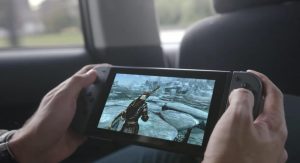
What if the world of Skyrim actually responded in a meaningful way to your travels around the real world?
Let me give you an example of what I have in mind. Imagine a game in which the avatar has some kind of quest to complete in their “real world” (i.e. the avatar’s real world, not the player’s). However, the avatar also has a unique ability: at night, he can use his dreams to access a parallel dream world to allow him to advance in his quest in altogether different ways. This dream world, unlike the avatar’s real world, is directly linked to the player’s real world: using location-based data (maybe collected from Wi-Fi networks, or whatever), the game generates dream-world locations that correspond to nearby locations in the player’s world. Maybe these correspondence relations are somewhat direct—maybe, for example, real libraries in the player’s world serve as dream-world libraries that provide new, uniquely useful information on the game’s world and characters. Or maybe the correspondence relations are more symbolic: maybe major landmarks in the player’s world correspond to something like procedurally generated dream dungeons in which the avatar can acquire unique abilities, equipment, and the like.
Such a game would make the dynamic, hybrid nature of the Switch directly significant to the game’s story by making the game’s world responsive to the player’s movement throughout her real world. Instead of merely playing the same game anywhere, this shows that players of the Switch could actually have the chance to play games that tell stories about their being played anywhere.
This idea is especially exciting to me because I think it builds well on infrastructure that Nintendo already has: the infrastructure of Pokémon GO. The augmented reality of Pokémon GO is all about mapping fictional structures, like Pokéstops and Pokémon Gyms, onto corresponding, real-life landmarks (e.g., finding a Pokéstop in the game’s app at your local pharmacy). I see the Switch taking this kind of location-based storytelling one step further: instead of just taking a map of the player’s real world and adding some fictional locations and Pokémon on stop of it, games on the Switch could have robust, fictional worlds of the variety we’ve come to expect in AAA games, and these worlds could vary their content in accordance with where the player is in the world—and, contrariwise, the worlds could remain static when the player decided to simply stay at home.
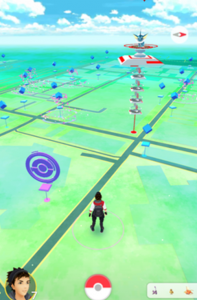
Pokémon GO’s AR could end up being a precursor to more robust and dynamic integration of the real world with fictional worlds on the Switch.
It’s trite but true that video game consoles are like windows to other worlds. The Switch can take video-game storytelling to the next level by building worlds that fundamentally change in response to the window itself changing—when it changes for instance, by moving with the player across real space and time.
3. The Player Hive Mind: Dynamic Player-Player Interactions on the Switch
From the very first ads for the Switch onward, Nintendo was upfront about the idyllic goal they had of their new console bringing people together: when you’re heading out to meet some friends, just grab your Switch, bring it along, give everyone a Joy Con, and fire up Mario games on a rooftop somewhere.
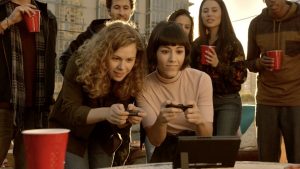
“Finally, we can play Mario together at our rooftop parties in the 90’s!”
That’s a nice idea, no doubt, but it doesn’t obviously make a difference as far as storytelling is concerned: sure, you can play Mario Kart anywhere now, but that doesn’t seem to mark any deep storytelling difference in the fiction of the Switch’s Mario Kart 8 Deluxe versus Mario Kart 8 for the Wii U.
That’s why I think it’s surprising that the Switch really does have the potential to change player-to-player relations in ways that have crucial implications for the storytelling of video games. In particular, I think the Switch can make narrative meaning out of bringing players together, while preserving players’ freedom to play games independently of other players if they so choose.
I discussed above how the Switch could potentially exploit its portable nature to map its game worlds onto the player’s real world; a natural extension of this is that it could also potentially map its game worlds onto other players and their avatars.
Pokémon GO is again a useful basis for what this could look like: players of Pokémon GO are able to congregate around real-world locations, designated fictionally as “Pokémon Gyms,” and team up with other real-world players in that same location to fictionally battle in the gym against the Pokémon of players on opposing teams.

Pokémon GO Fest is a prime example of the augmented reality game bringing real-world players together.
Pokémon GO is a good basis for what the Switch could do, but it doesn’t go as far as the Switch could in bringing players together in fictionally meaningful ways. Notice that Pokémon GO is limited in the sense that it doesn’t have a robust fictional world of its own, defined independently of the player’s real world: it builds up its fictional world from the player’s real world, simply turning real locations into fictionally meaningful locations like Gyms (this, I take it, is one way of making precise what it means for a game to be a case of augmented reality).
The Switch has the opportunity to build robust fictional worlds that exist independently of other players, but that also can interact with other players in narratively meaningful ways based on player location. Consider the following example to see what I mean.
Imagine a game that’s like Dark Souls in the following sense: it has a world and quest that’s perfectly well-suited for a single player and avatar to traverse, playing through a story from beginning to end; yet it also has multiplayer functionality, supported by a narrative explanation of that functionality: there’s some kind of item in the game’s world that allows avatars to summon other avatars (and, consequently, other players) from other “dimensions,” or planes of existence, or whatever spatiotemporally distinct form of existence you prefer. This game spells out the fictional mechanics of this summoning process in more detail than Dark Souls does: in particular, it’s part of the game’s fictional universe that these avatars are controlled by “spirits,” powerful extra-dimensional gods who have taken a special interest in these avatars for one reason or another. “Summoning” taps into the fabric of the game’s universe and causes these gods to resonate with each other, and—crucially—the closer the gods are to one another, the stronger this resonance is. In practice, that means that when real-life players are literally closer to one another, their avatars can summon each other and get all kinds of additional abilities that they couldn’t get otherwise: maybe players’ being within a certain radius of each other would allow their avatars, upon teaming up, to access supremely powerful magic, or to access the special abilities of other classes (e.g., a knight could use the others of a mage), or other kinds of powers altogether.
The result would be a game that a player can play perfectly well solo, but that also incentivizes players—within the context of the game’s fiction—to physically connect with other players. Even players summoning other players remotely, from the comfort of their own home, wouldn’t get the special benefits that players who met up would get. And, crucially, the game’s story would have the resources to explain in a compelling way why these bonuses function in the way that they do: in our example, the bonuses make sense because the gods being closer to each other allows their power to resonate more strongly than otherwise possible (and this explanation could of course be fleshed out more thoroughly depending on the other details of the game’s story and world).

This kind of storytelling would give real, narrative meaning to player teamwork—more reason than ever to actually meet up and game with friends.
The ability to take a Switch to your friend’s house is nice, but it’s just a frill if it doesn’t make a difference to the actual stories that you and your friends are playing together. Thankfully, this needn’t be the case: it’s well-established at this point that players have a fictionally meaningful impact on the worlds of the games that they play, and the portable, online capacity of the Switch has the potential to make player proximity and interaction equally meaningful to video-game worlds.
Would this kind of storytelling be just as feasible on another portable system, like the 3DS? Only to a limited extent. The 3DS certainly has the capacity to bring players together in the way I just emphasized, but its status as a purely mobile console, rather than a hybrid console (e.g., the Switch), means that this kind of player-player interaction will almost certainly have a different meaning in the context of games’ broader fictional worlds. Portable consoles are best suited for establishing worlds that are inherently flexible with regard to where and how the player can access them: rather than game worlds having a particular metaphysical “point of access,” as was the case in the original Majora’s Mask, portable consoles present games with worlds that are able to metaphysically “follow” the player throughout the real world, as was the case in Majora’s Mask 3D.
The result of this characteristic of portable consoles is that the dynamics of something like the gods-interactions I outlined in our toy example game above would be foundationally different on a portable console than on a hybrid console like the Switch. Were such a story and world developed for the 3DS, the portable, untethered nature of the console and the game’s world would imply that the “gods” (i.e. the players) were always comingling with each other, traveling throughout their god-world, sometimes being close to each other, other times being far apart from each other. Contrast this with the Switch, where such portability is possible, but the player’s TV also provides a kind of “home base” with which to engage the worlds of video games. In this case, it needn’t be implied that the commingling of gods is a constant and necessary state: instead, mirroring the hybrid structure of the console itself, it could be the case that the player’s TV acts as a unique tether between the player—a singular god—and the world of the avatar, while the player can also take the console portably, depart into the broader realm of many gods, and interact with her god-peers.
Why does this kind of subtle difference matter to the storytelling of games? Well, in the case of our hypothetical game on the Switch, we’ve ended up providing a narrative basis for the player’s freedom to either play the game in an isolated way, or play the game in collaboration with other players: the game’s fiction explains that gods can either independently access the game’s world, or else enter the broader domain of gods and team up with other gods. In contrast, because this distinction doesn’t exist on the purely portable 3DS system, the player of our game’s 3DS version is always understood to be playing in tandem with other gods, and thus the narrative implies that they need to be interacting with these other gods (and, by extension, with other players). This is exactly what we see, for example, in Pokémon GO: because there’s no concept within the game’s world of players engaging the world in total isolation from other players, there’s a tacit implication that players must always be interacting with each other.
The Switch, then, is in the special position of fictionally incentivizing player-player interaction, without thereby fictionally mandating player-player interaction. This gives players a high degree of flexibility in how they engage the stories of games, making a player’s decision to either stay home alone or go out and play with other narratively meaningful.
Conclusion: Console Dynamism and the Roles of Players
We’ve seen that the dynamism of the Switch as a hybrid console has the potential to translate directly to new kinds of storytelling dynamism in video games, inviting new kinds of player-avatar relations, player-world relations, and player-player relations. It’s worth noting the obvious here: all of the storytelling innovations I’ve identified on the Switch centrally depend on making narrative meaning out of the player’s interactions with video games—and the nature of those interactions are transformed in virtue of the Switch’s special status as a hybrid console.
I don’t think this is a coincidence—after all, I began this article by noting that consoles have the potential to impact video-game stories in virtue of mediating players’ influence on those stories. But I think that the presence of so much storytelling potential in these player relations is also symptomatic of something deeper.
Especially in recent times, developers have been laser-focused on the notion of erasing any and all distinctions between player and avatar, trying to make the player feel as if she “really were” the avatar as thoroughly as possible. This, I think, is the goal that people tacitly have in mind when they say video games should be more “immersive”; this, I think, is what top UI designers have in mind when they say that UI should aim to be as invisible to the player as possible. Put bluntly, many games seem to be trying to get as close to virtual reality—where the distinction between player and avatar collapses—as possible.
I think that taking the collapse of the player-avatar distinction to be the ideal to which all games must aspire is an ill-conceived mistake. I argued extensively in my ontology of video games as a storytelling object that players simply don’t embody avatars, taking on the role of the avatar as they play the game. I think that this incorrect embodiment view of player-avatar relations is largely to blame for the desire to collapse the player-avatar distinction. After all, if you think that what a player does by playing a video game is take on the role of the avatar, it’s natural to ask how the player can take on that role more completely, to the point that the player just is the avatar (i.e. virtual reality). If you instead reject this embodiment view (as I do), then it’s much easier to recognize that video game stories can do many rich and unique things precisely by exploiting the fact that the player and avatar are not playing the same role within the fiction of video games.
But even if you aren’t familiar or on-board with my overall ontology of video games, the above analysis of the Switch should make clear enough that video games can tell entirely new kinds of stories when they use player-avatar, player-world, and player-player relations as central aspects of those stories.
The ironic thing is that video game hardware, like the Switch, seems obsessed with finding new and exciting ways to involve players with video games—the storytelling just doesn’t seem to have caught up yet.

[1] Here and elsewhere, I’m using the language of the player “controlling” the avatar as shorthand for the player making it the case that the avatar does such-and-such. Those who have read my work on the ontology of video games as a storytelling object know that I think it’s wrong to claim that players directly control or embody their avatar; however, I think my observations about the storytelling capabilities of the Switch will ring true regardless of whether you agree with this more foundational view of player-avatar relations.
[2] It’s of course true that the Wii was technically able to support games that used symbolic controls, and its “classic controller” was designed in such a way as to make these controls easy and natural to use. But the problem is that the console itself wasn’t designed in such a way as to make these two modes of avatar manipulation integrated with each other in a compelling way: either games used the motion controls in a thoroughgoing and essential way (e.g., Skyward Sword), or they virtually ignored them (e.g., Xenoblade Chronicles). The controller of the Wii was designed for motion: it was meant to be gripped and swung around in your hand, which was what made it so hard to integrate symbolic control systems into its games. On the other hand, if a game abandoned the motion controls and only used symbolic control systems, the controls would either (1) feel awkward if using the Wiimote (because you weren’t using it for its intended purpose—like brushing your teeth using a spoon as a toothbrush) or (2) feel like a GameCube, rather than a Wii at all, if you were using the “classic” controller. So while the system itself could technically support games that did or didn’t use motion controls, it was a far cry from integrating the two in the way that the Switch potentially can.
[3] Well, the bow of your avatar, anyway: I’ve argued elsewhere that your avatar in Breath of the Wild is a far cry from the Link you might think he is.



